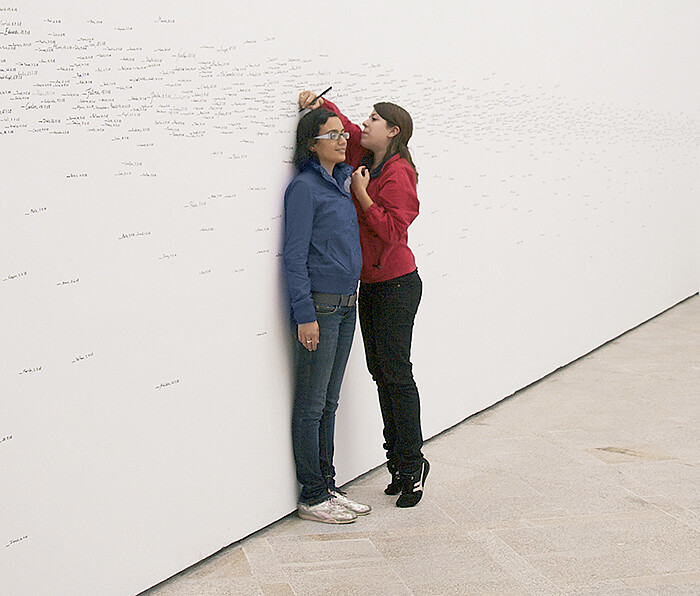At the core of the work of Slovakian artist Roman Ondák is the sometimes hopeful, sometimes melancholic reflection on the character and experience of human community, society, and its institutions; in the background, the question hovers of how individuals are obliged to live alongside each other, in the humdrum every-day. Ondák’s neo-conceptualist techniques, in fact, yield affective emotional values, using communities of people as the raw material of the work. In his Measuring the Universe (2007), the otherwise empty gallery walls record the height of gallery visitors, in black marker, their grand accumulation producing a hazy band of black-on-white that combines the statistical anonymity of demographics with the intensely personal gesture of the handwritten index: every mark represents a human life, each one a “this is me,” in the throng of common humanity. Similarly, Ondák performed an absurdist action in Good Feelings in Good Times (2003), restaged at frieze art fair in 2004) by hiring professional actors to form a queue outside the British Council building in Cologne. Though what these people were queuing for is never clear, at some point it becomes a gentle comic play on the etiquettes and tolerances of our daily encounters with each other.
For his installation at Kunsthaus Zürich, Ondák plays out these broader themes across the axis of European history by specifically invoking the former Soviet Union and his own personal past (Ondák’s home is Slovakia). Enter the Orbit comprises 96 miniature models made from everyday bric-a-brac, each vaguely resembling the first ever space satellite, the USSR’s Sputnik 1–a spherical body with four long backwards-projecting antennae. Mounted in an eye-level line along the gallery walls, these humble miniatures were made by Ondák and his friends: 96 models for the 96 minutes it took for Sputnik to orbit the earth. In the lobby-like gallery that precedes the main presentation lies a sack made from heavy canvas, titled After Return from Orbit (2011), its odd shape suggesting that its shrouded contents are, impossibly, Sputnik 1 itself. A postage sleeve fixed onto the sack is addressed to Ondák at “1 Sputnikova, Bratislava, Slovakia,” but with a 1958 postmark stamped over 1957 USSR stamps, commemorating the launch.
This fantastical resurrection offers us an uncanny encounter with history and distance, the distance between the personal and societal, between the gigantism of political events of the twentieth century and the gesture of an art object, lying on a gallery floor in the twenty-first. Ondak’s project astutely evokes the peculiar sense of loss that afflicts us in the post-Cold War era. The Eastern Bloc may have turned out to be failed experiment, but the subsequent decades of neoliberal capitalism have not yielded a more optimistic, happy world. Sputnik 1 becomes a sort of revenant, a ghost of a time in which society, whether capitalist or communist, still had hope in and ambition for a better future. These lowbrow, handmade replicas of Sputnik 1 suggest a tentative gesture towards some form of regenerated communal endeavor–and though the models may be primitive, they evoke a possibility of working together, of the possibility of a common cause and a collective sense of direction.
Or perhaps we’re always incredulous of how much our grandparents really believed in the futures they were working (and fighting) towards. As a sort of post-script to the show, Ondák interferes with a bigger display of sculptures by Giacometti in the Kunsthaus’s adjoining rooms. Some of Giacometti’s tiny figurines, each no bigger than a matchstick, are displayed in large vitrines. Into the empty expanses in which they stand, Ondák scattered a few little nuggets of gold. Titled Man, Art and Gold (2011), Giacometti’s brittle lost men are put into the bitter context of market anarchy—and of the failure of art to transcend this context in any way. It’s a harsh negation of the fragile optimism of Enter the Orbit. But then again, perhaps it points to the limits of art to ever really affect—for better or worse—the real social world and the greater forces of human history.





